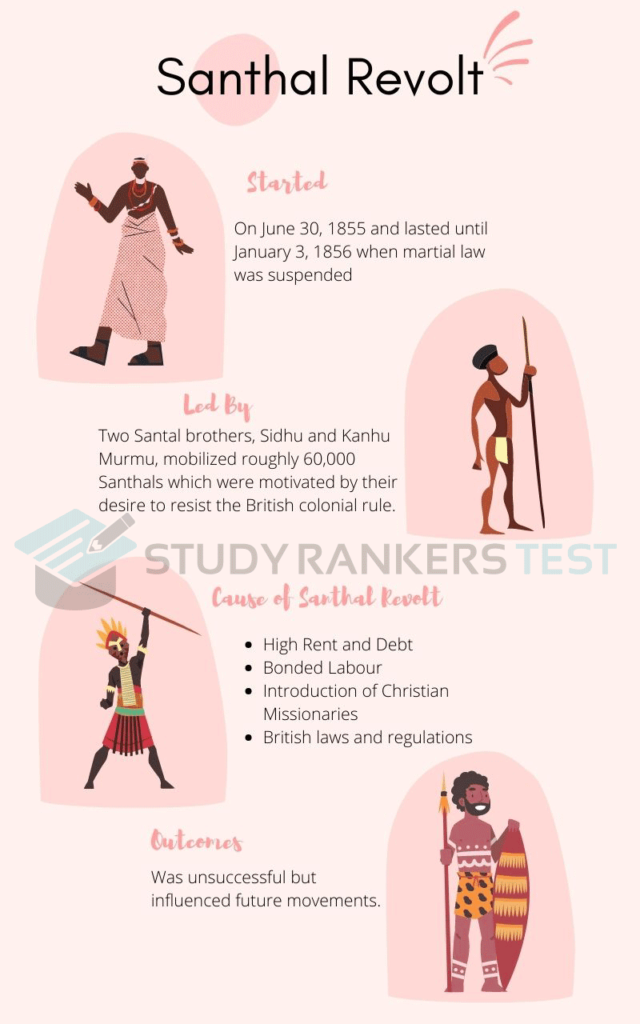The Santhal revolt was a peasant uprising that took place in 1855-56 in the Indian state of Bihar and Jharkhand. The Santhals, who are an ethnic group indigenous to the region, were angry about their treatment by the British authorities, and rose up in rebellion. The British responded harshly, and many Santhals were killed or arrested. The revolt ultimately failed, but it helped to bring attention to the plight of the Santhals and led to some improvements in their situation.

Who were Santhals?
The Santhals are a Scheduled Tribe who inhabit the areas of Bihar, Jharkhand and West Bengal states in eastern India. The Santhals started settling down in the foothills of Rajmahal in around 1780s. Zamindars, Moneylenders (Mahajans and Sahukars) and British administration gave Santhals land and persuaded them to settle down in Rajmahal and to push Pahariyas (hill people) out from the lower hills. The Santhal people are an indigenous people of India who relied on the forest for their survival. They hunted and gathered food in the forest, and their culture and way of life were based on their close relationship with the natural world.
In 1832 legislative session, a large number of areas were designated as Damin-i-Koh or Santal Pargana. In the beginning, they were supportive of local Zamindars, Mahajans, Sahukars, as well as Britishers (collectively known as ‘Dikus’ or outsiders). Soon, however, things began to change and Santhals began to lose control of the cultivated land they had cleared.

Social Life of Santhal
There is a communitarian pattern in Santhal’s village. When Santhal villages were formed, Santhals did not receive land physically, but it was distributed to them by the village headman. It was only after he had put his holding under cultivation that he was able to own it permanently. Pradhan, the village chief, approved the exchange of land.
Santhals pay rent on land collectively. The rent is calculated according to how much land is cultivated, and the tax is paid by the community as a whole. A Santhal who defaults on his payments loses his land, which becomes the property of his headman once the arrears accumulated against him have been cleared. Lands belong to the village stock if a Santhal dies without leaving an heir. As there is no competition for accumulating wealth in the Santhal society, there is a perfect harmony.
Background of Santhal Revolt
Lord Cornwallis established the Permanent Settlement in Bengal, Bihar, and Orissa in 1793. Zamindaris were able to exploit peasants at their will under this revenue system, thereby creating resentment in many parts of the country. Gradually, the British began playing their old debt-trap game in the area of Santhal. British traders introduced money to them. Their money management and calculation skills were poor. However, the British slowly began to raise the land revenue rates. Consequently, they had to take out loans to repay the taxes, which further deteriorated their financial situation. Money lenders and zamindars encroached on their land after they failed to repay the loan. Even the government and police were involved in this treachery. Eventually, the Santhal group realized that their land holdings were at risk and the government had tricked them into signing agreements. Various ways were also used by the moneylenders to cheat the Santhals. They were the most exploited group. Moneylenders usually demanded double the amount they normally claimed. Moneylenders’ mischief forced the Santhals to express their anger, and they were considered lawless.
Course of Santhal Revolt
The two Santhal brothers Sidhu and Kanhu Murmu organised 60,000 Santhals and started rebellion against British on 30th June 1855. They were motivated by their desire to resist the British colonial rule and to protect their traditional Santhal way of life. The two brothers who led the Santhals, declared the territory between Bhagalpur and Rajmahal independent.
Traditional armour like Bows and Arrows was taken up by the villagers as they bowed to Swaraj. In Sidhu’s and Kanhu’s rebellion, their sisters, Phulo and Jhano Murmu, also participated and killed many enemy soldiers. Sidhu and Kanhu promised new revenue policy and natural justice based on their traditional system of justice. In order stir up religious sentiments among the revolutionaries, Sidhu told his tribe people that Singh Bonga, the God of Santhals, appeared to them and ordered them to fight against Dikus and establish Swaraj over Damin-i-Koh.
Santhals attacked British authorities and police during the uprising. The Mahajans and Sahukars were also looted and murdered. Shortly thereafter, it spread from the Damin-i-Koh region to Dhanbad, Bhagalpur, Singhbhum, and Virbhum. The number of revolutionaries increased almost ten-fold.
Suppression of Santhal Revolt
The British government crushed it with a heavy hand. In Damin-i-Koh region, the British administration immediately imposed Marshal Law. With the assistance of ten battalions of the army, Major Baro tried to contain the revolt; however, he was unsuccessful.
In response to the failure of Major Baro and his battalions, British administrators deployed a large army unit under the leadership of Captain Alexander and Lieutenant Thomson to suppress the rebellion. With spears and arrows, tribal warfare was no match for British firepower. About 15000 Santhal villagers were killed and their villages destroyed, including the Murmu brothers.
Cause of Santhal Revolt
Economic Causes
The rent was fixed on the classification of the soil. The rates in Damin areas were lower than the rates in the zamindari estates. Mahajans who came to Damin sought to exploit the Santhals as much as possible in order to accumulate wealth. Traditionally, the Santhals were lured into borrowing money in order to exploit them. The once-borrowed money was spent in a hurry and they went on to borrow more. In the end, the thriftless Santhals were trapped in a vicious debt trap from which they had difficulty escaping.
Santhals’ authority over forest resources was restricted by the British Forest Policy, which created much disappointment among them. The railway track between Bhagalpur and Vardhwan was forcedly laid down by the Santhals without pay. In Assam tea plantations, Santhals were also recruited. They were recruited by contractors and paid a miserable wage; they worked under horrible conditions and were unable to return home.
Religious Causes
Christian Missionaries were allowed to propagate Christianity in India by the Charter Act of 1813. During the Christian missions in India, they targeted tribes and threatened the traditional beliefs and customs of Santhals as well.
Political Causes
Santhals have traditional Manjhi and Parha Panchayat systems, which involve group decision making and self-determination in the village. These two systems were heavily influenced by British laws and regulations.
Outcome of Santhal Revolt
In spite of its failure to achieve Swaraj, it influenced future movements such as 1857 revolt. In the aftermath of the Santhal Uprising, the weaker sections of society, who had been afraid of the Britishers and upper cast groups became more empowered and confident.